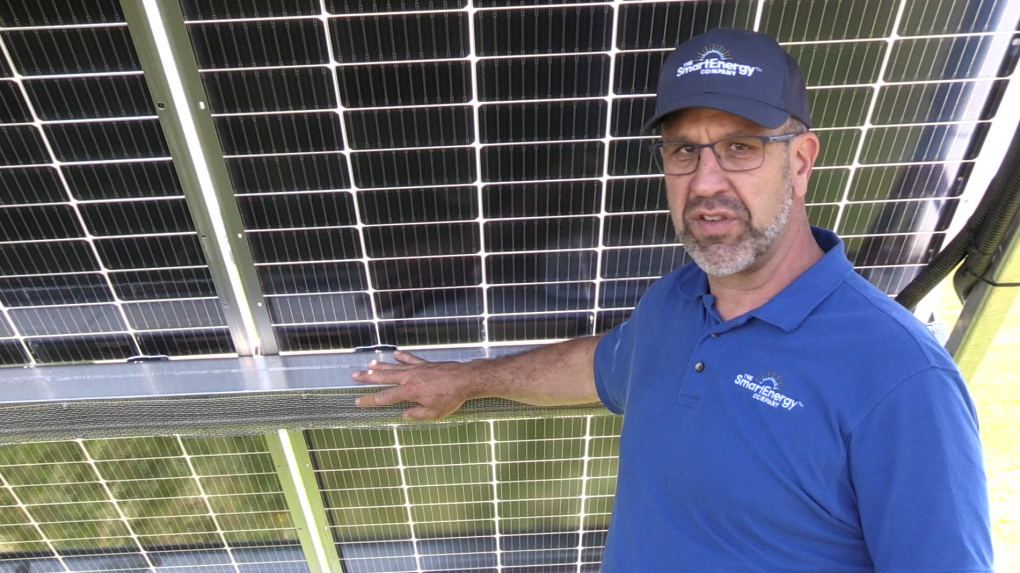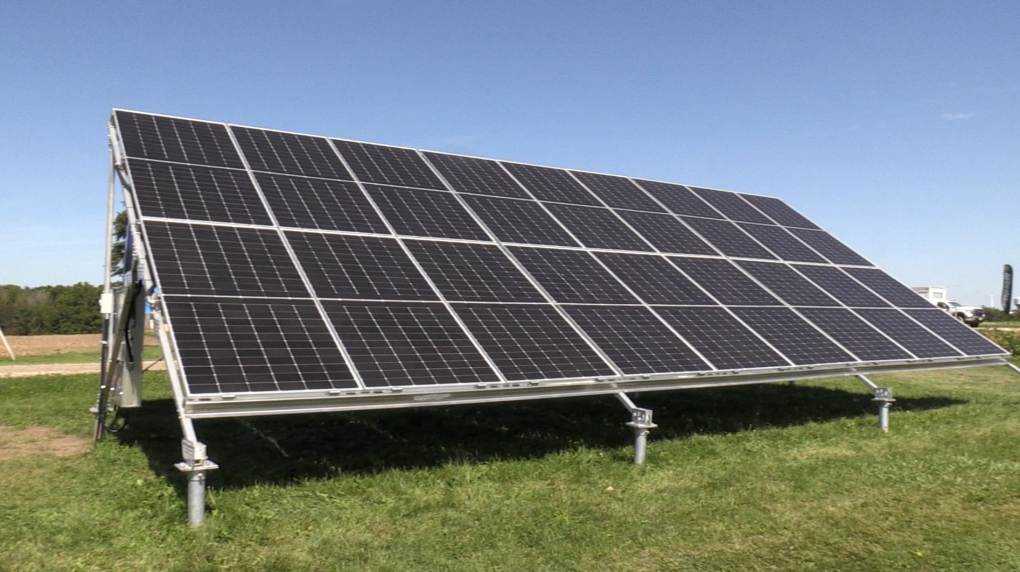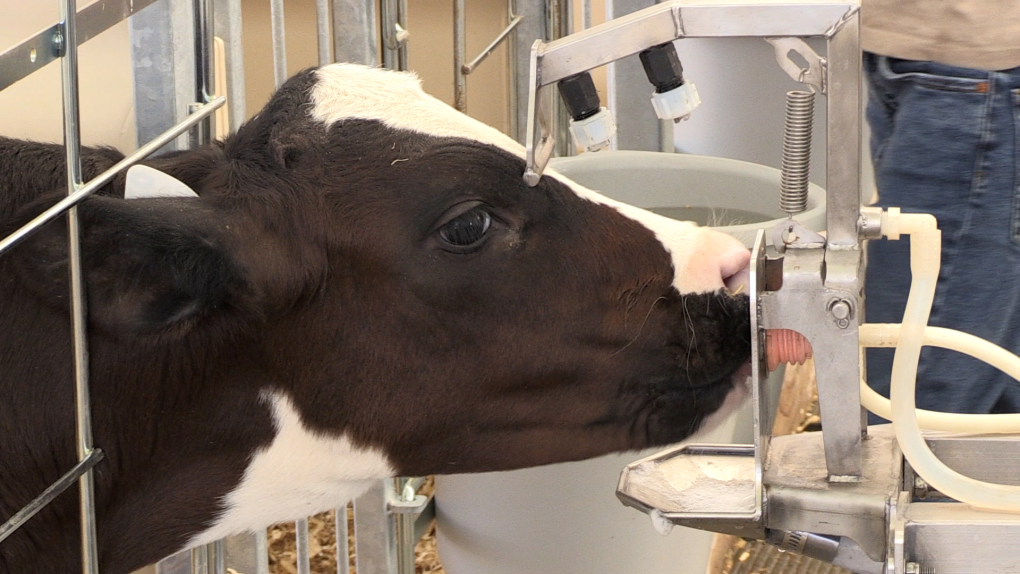New advancements in technology are helping farmers save money and time
A company that builds micro solar farms is trying to help farmers reduce their power bill
Smart Energy Company offers solar panels to farmers, saying after a few years it can help some producers get rid of any need to pay for power
“We can cut out most farms’ power bill entirely,” Jeff McAloon, Co-Owner of the Smart Energy Company said
Founded by McAloon’s brother in New Brunswick in 2016, the company started focusing on finding solar solutions for farmers two years ago. It expanded into Nova Scotia, Prince Edward Island and Ontario this year
“Far and away, the number one reason we hear from farmers that they want to get rid of their costs because they’re tired of the dramatic and unpredictable increases in electricity bills,” McAloon said
 Jeff McAloon, co-owner of the Smart Energy Company, stands in front of a solar panel system on September 10, 2024. (Colton Wiens/CTV News)
Jeff McAloon, co-owner of the Smart Energy Company, stands in front of a solar panel system on September 10, 2024. (Colton Wiens/CTV News)
McAloon said as long as the farm uses electricity the system can work
The company has also patented integrated wiring into the frame, so no fencing needs to be built around the structure
“Our utility fence, in essence, is built into the structure of the solar farm. So no need for an expensive fence,” McAloon said
At least two people are needed to build the structure, but it can be done in one or two days, followed by a little bit of electrical work
“Now about 90 per cent of our customers choose to build the system themselves. The farmers’ electricians, of course, have to do the final electrification, but the structure can be done by a farmer following instructions,” McAloon said
Because snow can block solar panels from producing electricity, the company only installs the structures on the ground. It uses what it calls bifacial solar modules that allow the panels to receive light on the backside of the structure. So sunlight reflecting off snow on the ground can still be received by the panels. It also helps heat up any snow that might be on the panels
“It almost creates a defrost mode on the front. By about 9:30 a.m., the snow automatically melts off,” McAloon said
Along with a 50 year warranty, customers can purchase a battery pack that helps manage usage and backup power. In some places, electrical credits can be put back into the grid
An app also allows customers to monitor the equipment from anywhere
“We’re a family company. Most farmers are family businesses. Our product is a long term solution that provides energy for generations,” McAloon said
 A Smart Energy Company solar panel is seen in Woodstock on September 10, 2024. (Colton Wiens/CTV News)
A Smart Energy Company solar panel is seen in Woodstock on September 10, 2024. (Colton Wiens/CTV News)
Another advancement giving farmers a little more time is the Uddermatic automated feeder
It’s a machine on a track, that can store enough powder and water to feed 15 calves, and removes the need for a farmer to feed each animal by hand
“Automatically feed calves as often in the day as you like. Day or night – it’ll do either powdered milk or whole milk,” Lester Martin, Owner of Uddermatic Inc. said
 A calf feeds from the Uddermatic system on September 10, 2024. (Colton Wiens/CTV News)
A calf feeds from the Uddermatic system on September 10, 2024. (Colton Wiens/CTV News)
The machine mixes up dry milk and water, then moves down the track to feed a line of calves. An arm swings out for any calves wanting to eat. Farmers can control the amount of milk coming out
The machine is fed by a hopper at the end of the track that holds ten or 12 bags of powder, and needs to be checked each day. Software tells the feeder when it’s empty. Similar to the solar panels, customers can control the machine from far away
“We have a tool that we can operate from the tractor seat in the back 40. We can do it while on vacation. We can actually keep tabs on the employees looking after the feeder based on the information we’re getting from the feeders,” Martin said
The hopper for the Uddermatic system is seen on September 10, 2024. (Colton Wiens/CTV News)
Martin dreamed up the idea about 12 years ago on his farm near Mildmay-Walkerton. He said it started with a stationary feeder that evolved into the moving feeder
“It wasn’t enough to feed more than 15 calves. It was very simple, too much competition,” Martin said. “I got thinking, why do I bring the calves to the feeder? Why don’t I take the feeder to the calves? That’s where that was spawned.”
Using the idea, Martin consulted some other people and the Uddermatic got off the ground
“I’m not smart enough to do it myself, but I know people who are,” Martin said
Martin has been working to upgrade the software, displays and touch panels and said it’s also used for feeding sheep and goats
A display screen for the Uddermatic system is seen on September 10, 2024. (Colton Wiens/CTV News)
It’s only available in North America right now. The only place Martin is not sure if it would work is outside
“I’ve been asked if it can be installed in hutches, and I still say I’m willing to try. But we haven’t yet,” Martin said